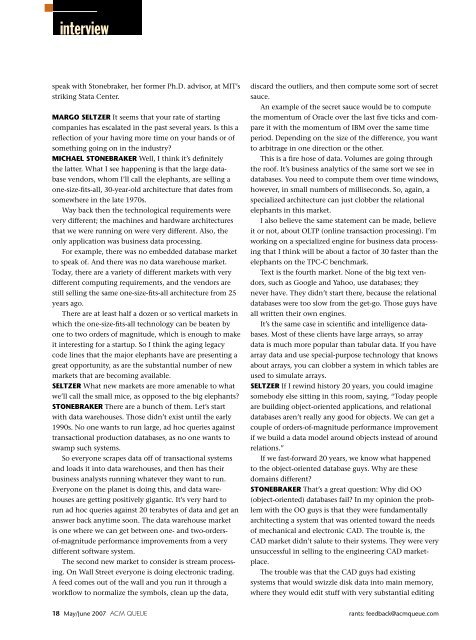API Design Matters Stonebraker and Seltzer - RabbitMQ
API Design Matters Stonebraker and Seltzer - RabbitMQ
API Design Matters Stonebraker and Seltzer - RabbitMQ
Create successful ePaper yourself
Turn your PDF publications into a flip-book with our unique Google optimized e-Paper software.
interview<br />
speak with <strong>Stonebraker</strong>, her former Ph.D. advisor, at MIT’s<br />
striking Stata Center.<br />
MARGO SELTZER It seems that your rate of starting<br />
companies has escalated in the past several years. Is this a<br />
reflection of your having more time on your h<strong>and</strong>s or of<br />
something going on in the industry?<br />
MICHAEL STONEBRAKER Well, I think it’s definitely<br />
the latter. What I see happening is that the large data-<br />
base vendors, whom I’ll call the elephants, are selling a<br />
one-size-fits-all, 30-year-old architecture that dates from<br />
somewhere in the late 1970s.<br />
Way back then the technological requirements were<br />
very different; the machines <strong>and</strong> hardware architectures<br />
that we were running on were very different. Also, the<br />
only application was business data processing.<br />
For example, there was no embedded database market<br />
to speak of. And there was no data warehouse market.<br />
Today, there are a variety of different markets with very<br />
different computing requirements, <strong>and</strong> the vendors are<br />
still selling the same one-size-fits-all architecture from 25<br />
years ago.<br />
There are at least half a dozen or so vertical markets in<br />
which the one-size-fits-all technology can be beaten by<br />
one to two orders of magnitude, which is enough to make<br />
it interesting for a startup. So I think the aging legacy<br />
code lines that the major elephants have are presenting a<br />
great opportunity, as are the substantial number of new<br />
markets that are becoming available.<br />
SELTZER What new markets are more amenable to what<br />
we’ll call the small mice, as opposed to the big elephants?<br />
STONEBRAKER There are a bunch of them. Let’s start<br />
with data warehouses. Those didn’t exist until the early<br />
1990s. No one wants to run large, ad hoc queries against<br />
transactional production databases, as no one wants to<br />
swamp such systems.<br />
So everyone scrapes data off of transactional systems<br />
<strong>and</strong> loads it into data warehouses, <strong>and</strong> then has their<br />
business analysts running whatever they want to run.<br />
Everyone on the planet is doing this, <strong>and</strong> data ware-<br />
houses are getting positively gigantic. It’s very hard to<br />
run ad hoc queries against 20 terabytes of data <strong>and</strong> get an<br />
answer back anytime soon. The data warehouse market<br />
is one where we can get between one- <strong>and</strong> two-orders-<br />
of-magnitude performance improvements from a very<br />
different software system.<br />
The second new market to consider is stream process-<br />
ing. On Wall Street everyone is doing electronic trading.<br />
A feed comes out of the wall <strong>and</strong> you run it through a<br />
workflow to normalize the symbols, clean up the data,<br />
discard the outliers, <strong>and</strong> then compute some sort of secret<br />
18 May/June 2007 ACM QUEUE rants: feedback@acmqueue.com<br />
sauce.<br />
An example of the secret sauce would be to compute<br />
the momentum of Oracle over the last five ticks <strong>and</strong> com-<br />
pare it with the momentum of IBM over the same time<br />
period. Depending on the size of the difference, you want<br />
to arbitrage in one direction or the other.<br />
This is a fire hose of data. Volumes are going through<br />
the roof. It’s business analytics of the same sort we see in<br />
databases. You need to compute them over time windows,<br />
however, in small numbers of milliseconds. So, again, a<br />
specialized architecture can just clobber the relational<br />
elephants in this market.<br />
I also believe the same statement can be made, believe<br />
it or not, about OLTP (online transaction processing). I’m<br />
working on a specialized engine for business data process-<br />
ing that I think will be about a factor of 30 faster than the<br />
elephants on the TPC-C benchmark.<br />
Text is the fourth market. None of the big text ven-<br />
dors, such as Google <strong>and</strong> Yahoo, use databases; they<br />
never have. They didn’t start there, because the relational<br />
databases were too slow from the get-go. Those guys have<br />
all written their own engines.<br />
It’s the same case in scientific <strong>and</strong> intelligence data-<br />
bases. Most of these clients have large arrays, so array<br />
data is much more popular than tabular data. If you have<br />
array data <strong>and</strong> use special-purpose technology that knows<br />
about arrays, you can clobber a system in which tables are<br />
used to simulate arrays.<br />
SELTZER If I rewind history 20 years, you could imagine<br />
somebody else sitting in this room, saying, “Today people<br />
are building object-oriented applications, <strong>and</strong> relational<br />
databases aren’t really any good for objects. We can get a<br />
couple of orders-of-magnitude performance improvement<br />
if we build a data model around objects instead of around<br />
relations.”<br />
If we fast-forward 20 years, we know what happened<br />
to the object-oriented database guys. Why are these<br />
domains different?<br />
STONEBRAKER That’s a great question: Why did OO<br />
(object-oriented) databases fail? In my opinion the prob-<br />
lem with the OO guys is that they were fundamentally<br />
architecting a system that was oriented toward the needs<br />
of mechanical <strong>and</strong> electronic CAD. The trouble is, the<br />
CAD market didn’t salute to their systems. They were very<br />
unsuccessful in selling to the engineering CAD market-<br />
place.<br />
The trouble was that the CAD guys had existing<br />
systems that would swizzle disk data into main memory,<br />
where they would edit stuff with very substantial editing
















